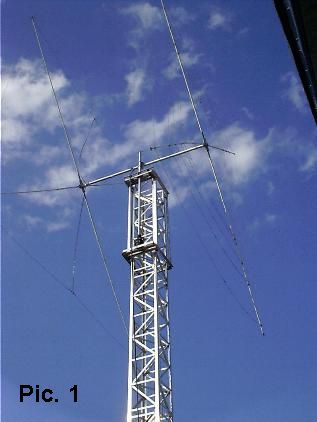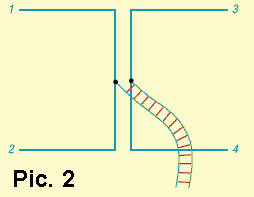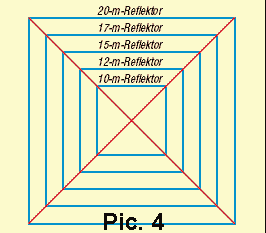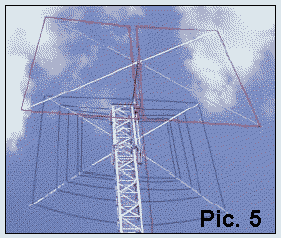
| source: www.mydarc.de/dk7zb/start1.htm |
|---|

2-Element-DK7ZB-Quad for 5 Bands
10-12-15-17-20m
A description was in the German Ham-Magazine "Funkamateur" in Issue 11/2003.
The picture shows the quad, built by DL1DTC
The Quad uses a single, central-feeded frame with a feeder-line. Therefore you must use an ATU for operating this antenna. Excellent would be a "Z-Match", a 1KW-Tuner will be described on another page.
The reflector has one loop for each band, self-resonant without stubs.
The first DK7ZB-Quad was introduced in 1995 and contented a mistake and not the best performance. In 2000 the Quad was optimized for 1-Lambda reflector loops with "EZNEC" by W7EL.

The basic priciple of the radiator element is the Lazy-H (Pic. 2), a special form of a stacked array of two dipoles, which are feeded with an open wire. The Lazy-H is a multiband-antenna with a low radiation angle an a bidirectional pattern and horizontal polarisation.
The points 1-2 and 3-4 have the same phase, therefore you can connect the ends together witout any disadvantage.
Pic. 3 shows this radiator element, which is no real "Quad" as you see above. This type of antenna was introduced first by DJ4VM. The full DJ4VM-Quad had two central feeded elements with this design. It needed a double-matchbox with phasing-lines for the feeding and was difficult to tune.
It is much more easier to use separate parasitic reflector elements for each band and to use a simple ATU. So you get a Boomquad with an element-distance of 2,60m.


Pic. 4: The 5 frames for the parasitic reflector, the distance between radiator and reflectors is 2,60m.
Very important: The wires must have 1mm diameter, with no insulation. I use copper-plates steel-wire ("DX-wire"). Simple copper will change the length in relation to the temperature!
Pic. 5 shows once more the basic principle of the 2-Element-Quad.
Because the frame on 10m and 12m is extended (Bisquare!), you get more gain than with a simple 1-Lambda-Quad.
Table 1 shows the mechanical dimensions, table 2 the electrical attributes for the 5 bands.

Table 1
|
Element |
Circumference |
Side length |
Spreader (one half) |
|
Radiator-Loop |
22,16m |
5,54m |
3,92m |
|
Reflector-Loop 20m |
21,96m |
5,49m |
3,88m |
|
Reflector-Loop 17m |
17,14m |
4,285m |
3,03m |
|
Reflector-Loop 15m |
14,72m |
3,68m |
2,60m |
|
Reflector-Loop 12m |
12,40m |
3,10m |
2,19m |
|
Reflector-Loop 10m |
11,48m |
2,87m |
2,03m |
Table 2
|
Frequency |
Gain in dBd |
F/B in dB |
|
14,0 |
5,53 |
6,8 |
|
14,1 |
5,33 |
13,1 |
|
14,2 |
4,75 |
18,8 |
|
14,3 |
4,15 |
13,9 |
|
18,1 |
4,0 |
18,8 |
|
21,0 |
5,74 |
7,8 |
|
21,1 |
5,67 |
11,5 |
|
21,2 |
5,47 |
16,3 |
|
21,3 |
5,22 |
21,2 |
|
21,4 |
4,95 |
19,2 |
|
24,9 |
5,9 |
11 |
|
28,0 |
6,25 |
9,1 |
|
28,2 |
6,18 |
9,4 |
|
28,4 |
6,11 |
9,4 |
|
28,6 |
6,0 |
9,2 |
|
28,8 |
5,9 |
8,7 |
|
29,6 |
4,8 |
5,3 |